Ever so often, new mommies and their tiny tots struggle to come to terms with their new routines and rightly so, it can be as flexible as it can get. As your baby grows, at every stage their needs only increase by manifolds. We are often asked to share ideas on how to build upon it. We hear you.
So let us begin by sharing my son’s routine when he was around 6 months. He is an early riser, with that being said, it gives us a lot of time for early morning snuggles and getting the day started. He wakes up at six in the morning and that lets us build our day from here. In the next half an hour I get him prepared to step outside.
In those 30 minutes, at first, I let him sip on to some lukewarm water and get his metabolism kick-started. Right after that, he poops and soon after the diaper from the previous night is also changed. I get him all dressed up according to the weather outside, to breathe in some fresh air and soak in the sunlight. From the very beginning, it has been our endeavour to explain Kabir (my son) that outdoors is meant to be active and to play games. While, the bedroom on the other hand, is for relaxing and to catch a nap.
We curate the activities for him in a way that he observes and grasps better. Getting him oriented to the objects around the house is another step in his initial grooming and a positive sensory response. Children at this stage observe as well as learn words and actions more than our comprehension. They pick and understand a new vocabulary with ease. During the next 45 minutes, the concentration is on activities involving skill building and motor responses. We let him play with his toys, followed by breakfast. We try to keep his diet full of cereal goodness and lots of seasonal fruits. This diet gives him lots of fibre and is a great energy booster.
 Since the day Kabir was introduced to solid food, we made it a point that he always sits on the feeding chair. This has dual advantages, firstly the fear of choking is completely negated and it inculcates a good habit since the very beginning. For many children who have a hard time sticking to one place during the feeding time, Mums can engage them by reading their favourite story, talking, playing and laughing with them. Use of television or any gadget during feeding time is not advisable at this age. Post breakfast, it’s time for him to play as his energy is fired up . Play is exercise for babies and it helps him catch his first nap of the day. During this playtime, it’s a good mix of physical activity using his favourite ball, moving around in the walker, crawling and grabbing the things that catches his fancy.
Since the day Kabir was introduced to solid food, we made it a point that he always sits on the feeding chair. This has dual advantages, firstly the fear of choking is completely negated and it inculcates a good habit since the very beginning. For many children who have a hard time sticking to one place during the feeding time, Mums can engage them by reading their favourite story, talking, playing and laughing with them. Use of television or any gadget during feeding time is not advisable at this age. Post breakfast, it’s time for him to play as his energy is fired up . Play is exercise for babies and it helps him catch his first nap of the day. During this playtime, it’s a good mix of physical activity using his favourite ball, moving around in the walker, crawling and grabbing the things that catches his fancy.
 Post his nap, he wakes up with his dad (my husband was doing night shifts during this period), and both of them play some brain engaging games like identifying objects and the like. Soon after he gets his first snack of the day, which is mostly a fruit. Kabir then steps out for some playtime in the park and meeting his peers. Now socialising isn’t just for adults. Even our tiny tots need it for an all-round development. Most of the time we have seen that children don’t respond well to new faces, both adults and children. They need to be exposed to adults, children and toddlers of different age groups alike. Such events only help them be more accepting and adjusting to a new environment and adapt easily. Practicing etiquettes and manners from an early age is a good idea.
Post his nap, he wakes up with his dad (my husband was doing night shifts during this period), and both of them play some brain engaging games like identifying objects and the like. Soon after he gets his first snack of the day, which is mostly a fruit. Kabir then steps out for some playtime in the park and meeting his peers. Now socialising isn’t just for adults. Even our tiny tots need it for an all-round development. Most of the time we have seen that children don’t respond well to new faces, both adults and children. They need to be exposed to adults, children and toddlers of different age groups alike. Such events only help them be more accepting and adjusting to a new environment and adapt easily. Practicing etiquettes and manners from an early age is a good idea.
 Now moving on to Kabir’s lunch time, it generally comprises of rice, pulses and fish. Post lunch, its entirely daddy-son time, where they get to bond. Fathers are not only huge role models for their kids, but also a companion, friend…a buddy of sorts. This is the time, when Kabir’s dad gives him massages, bathes him and plays with him. As a mother we get enough opportunities to bond and connect with the child, say during feeding.
Now moving on to Kabir’s lunch time, it generally comprises of rice, pulses and fish. Post lunch, its entirely daddy-son time, where they get to bond. Fathers are not only huge role models for their kids, but also a companion, friend…a buddy of sorts. This is the time, when Kabir’s dad gives him massages, bathes him and plays with him. As a mother we get enough opportunities to bond and connect with the child, say during feeding.
Post the relaxing bath and massage, Kabir is put down for an afternoon siesta, after which he wakes up in two hours, for his next snack. Snacking time can usually include food items such as vegetarian, non-vegetarian soups, mashed potatoes and much more, basically keeping a healthy mix of choices in the food options.
 Come evening, Kabir has two hours dedicated for playtime. It is pretty much similar to his morning routine, but we try to balance it out with both indoor and outdoor activities. The aim here is to tire him to a point ,where hitting the sack at the end of the day isn’t a difficult task. With planning out such activities, the problem of light or less sleep can be taken care of.
Come evening, Kabir has two hours dedicated for playtime. It is pretty much similar to his morning routine, but we try to balance it out with both indoor and outdoor activities. The aim here is to tire him to a point ,where hitting the sack at the end of the day isn’t a difficult task. With planning out such activities, the problem of light or less sleep can be taken care of.
Kabir’s dinner time usually consists of Chapati and Chicken, he relishes non-vegetarian food. Right after dinner, it’s time for the night time routine to kick in. He gets a clean-up, changes into his night clothes and gets moisturised. Well planned out routine for every part of the day, also trains the child’s mind eventually to know what to expect next.
 Once he sets into the bed time routine, mom and baby can indulge in a “quite play time” which include activities like reading a story, light music, nursery rhyme, lullabies or simply flash some animals and children’s characters on the wall using projector lamps. The best way to end the day is a lot of cuddles and snuggles. To a child’s mind that’s a huge positive reinforcement and a sense of security.
Once he sets into the bed time routine, mom and baby can indulge in a “quite play time” which include activities like reading a story, light music, nursery rhyme, lullabies or simply flash some animals and children’s characters on the wall using projector lamps. The best way to end the day is a lot of cuddles and snuggles. To a child’s mind that’s a huge positive reinforcement and a sense of security.
Over a period of time every child goes through changes in their routine, but our every endeavour should be towards comforting the baby. It is preferred to stick to one routine unless your baby’s stage demands a change. It takes about a minimum of 15 days to in-still fresh habits and routine in a child, but believe us, you will get there in spite of any resistance that you may experience. There will be times when the child is experiencing teething or any associated illness, an ongoing routine is bound to go haywire, do not fret such phases.
We are confident that the new parents out there are doing a great job already at identifying their baby’s patterns, but a little help and some novel ideas doesn’t hurt… isn’t it?! This was baby Kabir’s routine. Though we shared our family routine with you, restricting you under time stamps, would make parenting rigid. Adapt it as per your family structure. Catch a nap when you can. Happy parents raise happy children.
We would love to hear your experiences too. Your comments, questions and feedback are always welcome and feel free to share this article and spread the word amongst your friends and novice parents. Do share our enthusiasm to build a parenting community. Introduce more parents to MomcomIndia. We reach out to you via our pages on Facebook, YouTube, Instagram, Twitter and this website. We are confident that the new mums and dads out there are doing an incredible job already. Enjoy simplified parenting.
♥♥ 6 महीने के बच्चे का पुरे दिन का रूटीन, इस आर्टिकल में इस बारे में बताया गया है | इस आर्टिकल की जानकारी हिंदी में पाने के लिए नीचे दिए वीडियो को देखें ►







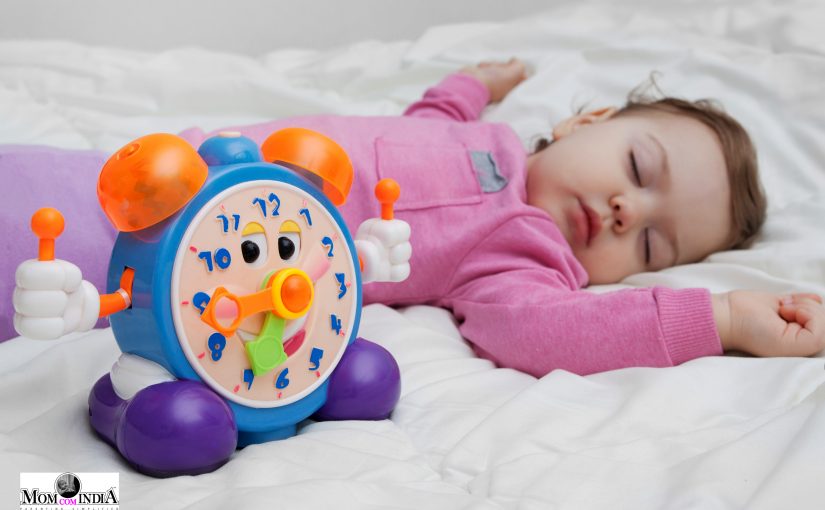

 Hunger ► Your baby didn’t have to make any effort in the womb to fill their tummy, once outside they have to make an effort to satiate their hunger. This effort of sucking is quite tiring for them, making them fall asleep either immediately after or often while feeding. Not getting adequate milk on the other hand can keep them awake. Many new mothers are unable to produce sufficient quantity of milk, this happens due to many factors. In my case I realized after a few days that my body is not producing enough milk in the evening to satisfy by babies’ hunger, which was making him cry constantly and impacted his sleep considerably. My recommendation will be to feed your baby for at least 15 minutes on each breast and try to keep your baby awake and sucking during this duration of time.
Hunger ► Your baby didn’t have to make any effort in the womb to fill their tummy, once outside they have to make an effort to satiate their hunger. This effort of sucking is quite tiring for them, making them fall asleep either immediately after or often while feeding. Not getting adequate milk on the other hand can keep them awake. Many new mothers are unable to produce sufficient quantity of milk, this happens due to many factors. In my case I realized after a few days that my body is not producing enough milk in the evening to satisfy by babies’ hunger, which was making him cry constantly and impacted his sleep considerably. My recommendation will be to feed your baby for at least 15 minutes on each breast and try to keep your baby awake and sucking during this duration of time. Gas/Colic ► Due to inconsistent feed, lack of adequate milk supply, introduction of baby formula and many other factors, newborn babies have to deal with gas problem. Discomfort caused by gas/colic can impact your baby’s sleep. In case of low supply your baby can suck in a lot of air while making an effort to feed, this air can cause gas problems in their tummy. Burping your baby immediately after the feed & doing it in the right manner can help reduce the chances of baby forming gas.
Gas/Colic ► Due to inconsistent feed, lack of adequate milk supply, introduction of baby formula and many other factors, newborn babies have to deal with gas problem. Discomfort caused by gas/colic can impact your baby’s sleep. In case of low supply your baby can suck in a lot of air while making an effort to feed, this air can cause gas problems in their tummy. Burping your baby immediately after the feed & doing it in the right manner can help reduce the chances of baby forming gas. Diapers ► I have nothing against cloth nappies or baby diapers, parents can prefer one or the other as there are many variables at play when it comes to using cloth nappies or diapers. You may have noticed that babies are not very comfortable with the nappy/diaper change process. Normal diapers do allow for a couple of pees compared to a cloth nappy which must be changed after every pee. So, depending on your babies sleep pattern you may want to make the right choice as per your babies needs.
Diapers ► I have nothing against cloth nappies or baby diapers, parents can prefer one or the other as there are many variables at play when it comes to using cloth nappies or diapers. You may have noticed that babies are not very comfortable with the nappy/diaper change process. Normal diapers do allow for a couple of pees compared to a cloth nappy which must be changed after every pee. So, depending on your babies sleep pattern you may want to make the right choice as per your babies needs. Environment ► The womb was a safe, quiet and warm environment. It’s important to keep these factors into consideration when you are making your baby sleep. Don’t under or over dress, my pediatrician always suggested one additional layer compered to ours and this became a rule of thumb for the first one year. We kept the AC temp in the room almost at the same level which suited our needs with our baby wearing one extra layer of clothing compared to ours. We also ensured we give our baby a quiet and peaceful environment to sleep in, you will be amused how babies can sleep even when there is a lot of noise around. That however should not encourage you to consider its okay to do that. When it comes to sleep it’s always better to create a quiet night type environment that your baby can grow used to over time.
Environment ► The womb was a safe, quiet and warm environment. It’s important to keep these factors into consideration when you are making your baby sleep. Don’t under or over dress, my pediatrician always suggested one additional layer compered to ours and this became a rule of thumb for the first one year. We kept the AC temp in the room almost at the same level which suited our needs with our baby wearing one extra layer of clothing compared to ours. We also ensured we give our baby a quiet and peaceful environment to sleep in, you will be amused how babies can sleep even when there is a lot of noise around. That however should not encourage you to consider its okay to do that. When it comes to sleep it’s always better to create a quiet night type environment that your baby can grow used to over time. ♥Swaddling– it works on most babies especially in the 0-to-3-month period. Swaddling is wrapping up your baby with a swaddle cloth in a womb like position and make them sleep in the swaddle as per their sleep pattern.
♥Swaddling– it works on most babies especially in the 0-to-3-month period. Swaddling is wrapping up your baby with a swaddle cloth in a womb like position and make them sleep in the swaddle as per their sleep pattern. ♥Massage– we have been massaging our son Kabir every day since his umbilical cord fell off and have done so till he completed 3.5 years age. This daily massage worked like magic and helped make him have a great nap each time. A massage relaxes their body and helps regulate blood flow, works on adults and even better on our little ones.
♥Massage– we have been massaging our son Kabir every day since his umbilical cord fell off and have done so till he completed 3.5 years age. This daily massage worked like magic and helped make him have a great nap each time. A massage relaxes their body and helps regulate blood flow, works on adults and even better on our little ones.
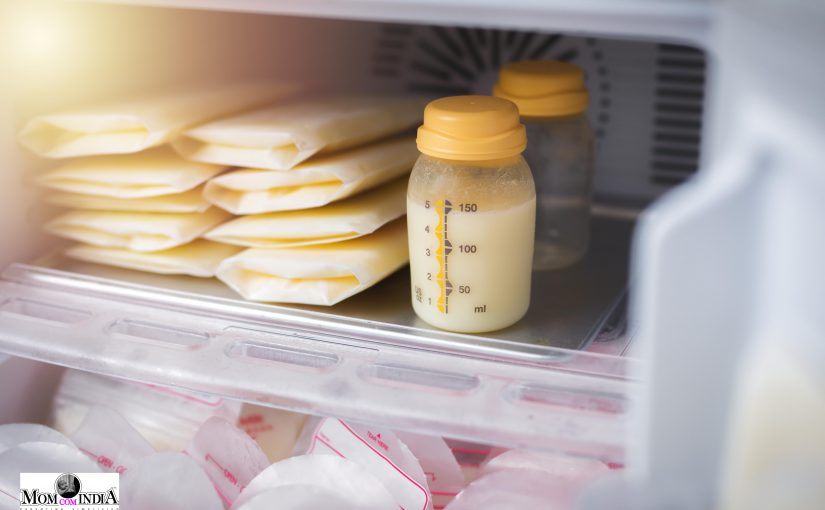
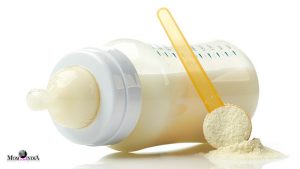 But let’s first speak about Formula milk, I believe it should never be stored. Always make it fresh. Making it is very simple using hot water and milk powder, and it should never be left out for more than an half an hour. Beyond that, it should be discarded. Make a fresh serving. Always store some hot water in a flask and keep it handy, to avoid last minute rush when the baby wails of hunger.
But let’s first speak about Formula milk, I believe it should never be stored. Always make it fresh. Making it is very simple using hot water and milk powder, and it should never be left out for more than an half an hour. Beyond that, it should be discarded. Make a fresh serving. Always store some hot water in a flask and keep it handy, to avoid last minute rush when the baby wails of hunger.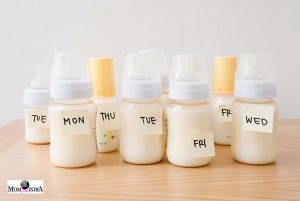
 It is highly important to store the milk in washed and sterilised bottles, always. Before every feed, it must be ensured that the feeding bottle too are sterilised. In-case of breast pumps, both manual and electric, every little washable part and accessory of the device must be washed and sterilised after every use. A quite common practise among parents is that they purchase storage and feeding bottles in bulk and wash and sterilise them all at once in a day. Keeping your baby’s health in mind, I’d personally recommend a use and wash regime for every bottle and pumping accessory that you own, so that we can ensure zero or minimum chances of infections and bacteria affecting your child.
It is highly important to store the milk in washed and sterilised bottles, always. Before every feed, it must be ensured that the feeding bottle too are sterilised. In-case of breast pumps, both manual and electric, every little washable part and accessory of the device must be washed and sterilised after every use. A quite common practise among parents is that they purchase storage and feeding bottles in bulk and wash and sterilise them all at once in a day. Keeping your baby’s health in mind, I’d personally recommend a use and wash regime for every bottle and pumping accessory that you own, so that we can ensure zero or minimum chances of infections and bacteria affecting your child. The next tip about milk storage in fridge includes the use of air tight bottles. This is done to avoid bacterial build up in the milk while it’s kept in the fridge. You must always store breast milk in smaller quantities. Storing in larger quantities and thawing it, can result in wastage of milk, in case the baby feeds less. Like I mentioned earlier that any left-over milk kept beyond 15 minutes needs to be discarded. If the baby needs more, you always have the option of bringing out another bottle. Ensuring smaller frequent feeds is the key. This will ensure lesser wastage and optimum nourishment.
The next tip about milk storage in fridge includes the use of air tight bottles. This is done to avoid bacterial build up in the milk while it’s kept in the fridge. You must always store breast milk in smaller quantities. Storing in larger quantities and thawing it, can result in wastage of milk, in case the baby feeds less. Like I mentioned earlier that any left-over milk kept beyond 15 minutes needs to be discarded. If the baby needs more, you always have the option of bringing out another bottle. Ensuring smaller frequent feeds is the key. This will ensure lesser wastage and optimum nourishment.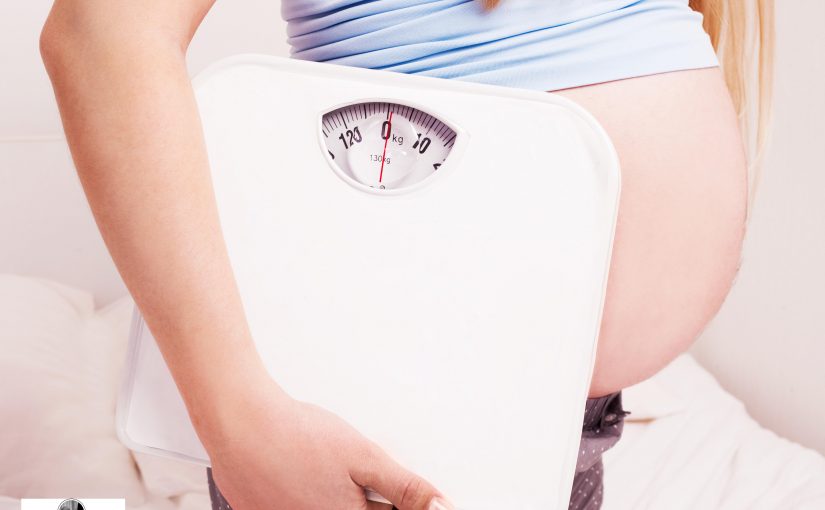
 A massage is a must. Normally, at least the first 40 days after giving birth, the mother should get her massages done. The oil massages have multiple benefits. It promotes better blood circulation, tones and shapes the body and takes care of the body aches, sore muscles and weak nerves post-delivery. Make an attempt to continue the massage. In my experience, I continued with body massages for up to four months. For the first-two months I took it every day. After that I continued on every alternate day, followed by once a week. Never get these done by an inexperienced person. These are specialised massages, curated only for post-partum mothers and done by a specialist, traditionally known as ‘Daimaas’. However, if you have had a C section, do consult your medical practitioner before starting the massages. Your stitches need time to heal and any strain on them may have long term impact.
A massage is a must. Normally, at least the first 40 days after giving birth, the mother should get her massages done. The oil massages have multiple benefits. It promotes better blood circulation, tones and shapes the body and takes care of the body aches, sore muscles and weak nerves post-delivery. Make an attempt to continue the massage. In my experience, I continued with body massages for up to four months. For the first-two months I took it every day. After that I continued on every alternate day, followed by once a week. Never get these done by an inexperienced person. These are specialised massages, curated only for post-partum mothers and done by a specialist, traditionally known as ‘Daimaas’. However, if you have had a C section, do consult your medical practitioner before starting the massages. Your stitches need time to heal and any strain on them may have long term impact. Another tip is to sleep well. As a mother it is hard for a nice long nap to come by. But it would be a great deal more beneficial if you are able to catch small naps along with your baby. During the initial months after birth, babies sleep a lot, so you can time your sleep accordingly. When we don’t sleep enough, we end up snacking at odd hours and anything that comes our way. Avoid junk food at all cost, at least for the first six months. During pregnancy, we eat a huge variety of food suiting our nutrition requirements as well as to satisfy the cravings. Once the baby is born, we slow down and eat only simple food groups, which are easy to digest as well as improve the quality and quantity of milk produced. Switching to healthy snacks is a good choice to avoid these hunger pangs.
Another tip is to sleep well. As a mother it is hard for a nice long nap to come by. But it would be a great deal more beneficial if you are able to catch small naps along with your baby. During the initial months after birth, babies sleep a lot, so you can time your sleep accordingly. When we don’t sleep enough, we end up snacking at odd hours and anything that comes our way. Avoid junk food at all cost, at least for the first six months. During pregnancy, we eat a huge variety of food suiting our nutrition requirements as well as to satisfy the cravings. Once the baby is born, we slow down and eat only simple food groups, which are easy to digest as well as improve the quality and quantity of milk produced. Switching to healthy snacks is a good choice to avoid these hunger pangs.